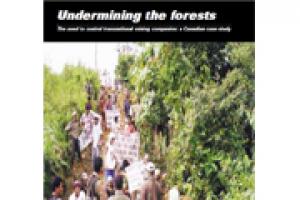It is estimated that already 40% of the Philippines territory has been given away under the form of concessions to multinational mining companies. However, this process has not happened without opposition. From the Cordillera region in northern Philippines to the South Eastern region of the Palawan Island, the Subanen, Tagbunau, Pala'wan, Tau't bato and Batak indigenous groups (see WRM bulletins Nº 11, 28, 67) have struggled to defend their territories from the pervasive impacts of mining.
Philippines
Bulletin articles
11 February 2003
Even though in 1992 the local government on the island of Palawan cancelled the concessions granted to logging companies (see WRM Bulletin 38) in an attempt to curb the destruction and degradation of the country's forests, it did not halt the threat to the integrity of the indigenous communities in the Philippines. There are also mining companies endeavouring to carry out their business in spite of the opposition of local communities and warnings about the environmental damage their activities will cause.
Other information
7 October 2002
The rapid depletion of Filipino forests by logging, mining and settler encroachment was officially acknowledged as requiring a policy response in the late 1980s. The need to limit and regulate logging and to promote community forestry alternatives was accepted by government by the end of the decade. In 1990, the government adopted a Master Plan for Forestry Development which entailed an attempt to ‘scale up’ previous community-level initiatives in forest management.
Bulletin articles
7 September 2002
The Philippine archipelago is extremely rich in both biological and cultural diversity. It is one of the world's 12 biologically mega-diverse countries and hosts about 127 main cultural groups.
Bulletin articles
14 May 2002
Many community-based forest management projects are implemented in the Philippines aiming at increasing community involvement in forest management and at providing employment and livelihood. Although there are many examples of successful cases, we decided to choose a less positive one, as a means to show how the exclusion of women or lack of gender awareness can lead to increasing gender inequalities, both within communities and in households.
Bulletin articles
27 October 2001
In the 1980s, shrimp farming became an industry when commercial availability of new technology from Taiwan, along with attractive export prices, led to the Shrimp Fever that swept the country and the rest of Asia. Filipino farmers shifted from milkfish (Chanos chanos) to shrimp, as well as intensified their culture systems from traditional and extensive to higher stocking densities.
Bulletin articles
11 September 2001
At the beginning of the 1950s, the Philippines still had some 100,000 sq. kms of primary forests, which had shrunk to some 10,000 sq. kms by 1988. The main beneficiaries of such destruction were the logging companies and wood consumers abroad. while its main promoter was the government itself who opened up the forest to "development".
Bulletin articles
12 March 2001
Vegetation maps published in Geography books still show the archipelago of the Philippines, as covered by dense tropical forests. Unfortunately, this does not correspond to reality any longer. Over the past 50 years almost two thirds of the country's forests --most of them primary-- have been lost, and nowadays forest cover is only 17 % --far below the original 60% of the country area. In 1990 the country's forest was down to only 16 million acres, 1,75 million of which was primary forest and only 50% of the original mangroves remained standing. The situation has since worsened.
Bulletin articles
13 January 2001
The San Roque Dam is to be located on the lower Agno River of Pangasinan Province, in the Cordillera region of Luzon island in the Philippines. If built, San Roque would be the tallest dam --at 200 meters-- and largest private hydropower project in Asia, generating 345 megawatts of power. Electricity generated by the dam would be primarily used to power industrial activity and the burgeoning mining industry in northern Luzon. Preparation of the site began in 1998, and construction is slated for completion in 2004.
Bulletin articles
17 September 2000
Palawan is an island of the Philippines, located in the Western part of the archipelago and surrounded by the South China Sea and the Sulu Sea. As a result of the democratic process started in 1992, the local government, in agreement with local communities and the private sector, cancelled existing logging concessions, and new legislation was issued banning all commercial logging on the island.
Publications
16 January 2000
by Forest Peoples Programme, Philippine Indigenous Peoples Links and the World Rainforest Movement
Bulletin articles
20 December 1999
Only 3% of the dense rainforests that once existed in The Philippines is still standing and less than 1% of the former forest is still in a pristine state (see WRM Bulletin 27). The Province of Aurora, which comprises a strip of land between the Sierra Madre mountains and the Pacific Ocean, is an exception, because unlike most of the country, it still maintains over 50% of its original forest cover, even some as primary forests. Along the coastline there are 430 hectares of mangroves.

